Marsha P. Johnson’s Place(s) in NYC’s LGBT History
October 6, 2017
The Death and Life of Marsha P. Johnson, a new documentary by David France, had its global premiere on Netflix today (tip to NYC locals: the film is also showing at the IFC Center).
We were fortunate to attend an advance screening of this moving film, which enforces the importance of Marsha P. Johnson and fellow activist, Sylvia Rivera, as early and critical advocates for trans rights (thanks to the LGBT Community Center for hosting this special event). A number of New York City locations and historic sites included in the film (rounded up below) stood out to us.
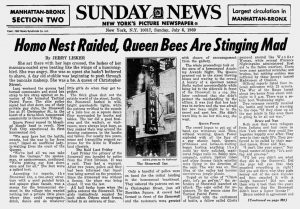
Article about the Stonewall uprising in the Sunday News, July 6, 1969.
The Stonewall Inn & Christopher Park
Marsha P. Johnson, and her involvement during and after the 1969 uprising, has received more and more (much deserved) attention in recent years. While Marsha herself admits that she did not show up at Stonewall until 2 am the first night, and therefore a few hours after the uprising began, she and other trans women of color, including Sylvia Rivera, were key participants who continued to play a crucial role in the fight for LGBT equality and transgender rights in the years to follow.
Visit our Stonewall Inn website entry (scroll down to “Related Media”) and listen as Marsha and Sylvia share their stories. Special thanks to project advisor Eric Marcus and his team at Making Gay History for providing us with these invaluable oral history interviews.
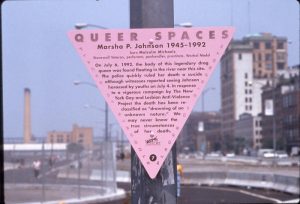
Pink triangle “Queer Spaces” signs were placed by RepoHistory at several NYC locations in the early 1990s to highlight sites of LGBT significance.
Christopher Street Pier
The pier and the Greenwich Village waterfront are shown throughout the Marsha P. Johnson documentary, illustrating their importance to her legacy. While already well-established as a gay cruising area from at least World War I, the pier also became closely associated with Johnson and Sylvia Rivera — both provided much-needed shelter, clothing, and support for homeless queer youth who lived and congregated on the piers.
On July 6, 1992, Johnson’s body was tragically (and mysteriously) found floating in the Hudson River near the piers. Her body was recovered and temporarily placed a half-block south of the Christopher Street Pier until transported to the morgue. The documentary follows Victoria Cruz, a friend of Johnson’s, as she tries to uncover the mystery behind Johnson’s death, which had been labeled a suicide (something those close to her never believed). A pink triangle was installed near the site of where her body was found in the early 1990s, as part of an initiative by RepoHistory to document important queer spaces in NYC. Read more about the waterfront’s LGBT history.
STAR House
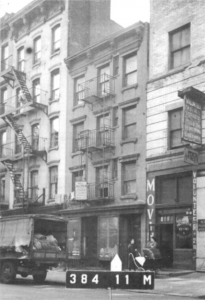 A number of LGBT rights organizations formed in the wake of Stonewall, including the Street Transvestite Action Revolutionaries (STAR), founded by Johnson and Rivera in 1970. Together, they established STAR House in a tenement at 213 East 2nd Street, in the East Village. This was STAR’s first (and it appears only) permanent home, providing refuge for homeless transgender youth from about November 1970 to July 1971. Rivera reflected on the space in a 1979 interview, “We had a STAR House–a place for all of us to sleep. It was only four rooms, and the landlord had turned the electricity off. So we lived there by candlelight, a floating bunch of 15 to 25 queens, cramped in those rooms with all our wardrobe. But it worked.”
A number of LGBT rights organizations formed in the wake of Stonewall, including the Street Transvestite Action Revolutionaries (STAR), founded by Johnson and Rivera in 1970. Together, they established STAR House in a tenement at 213 East 2nd Street, in the East Village. This was STAR’s first (and it appears only) permanent home, providing refuge for homeless transgender youth from about November 1970 to July 1971. Rivera reflected on the space in a 1979 interview, “We had a STAR House–a place for all of us to sleep. It was only four rooms, and the landlord had turned the electricity off. So we lived there by candlelight, a floating bunch of 15 to 25 queens, cramped in those rooms with all our wardrobe. But it worked.”
The building itself was unfortunately demolished by the 1980s and the lot remained vacant until a new residential building was constructed, but we were able to track down the above c. 1939 tax photo from the Municipal Archives.
Photo: The building that would become STAR House, in a c. 1939 tax photo. Courtesy of the Municipal Archives.
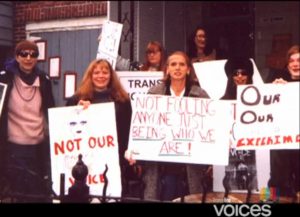
Chelsea Goodwin (left) and Rusty Mae Moore (center, with “Not Fooling Anyone…” sign), along with trans activists in front of Transy House. Source: “Changing House” documentary by Frameline Voices.
Transy House
While the documentary focuses on Marsha P. Johnson, it also highlights the work and influence of other notable transgender activists. Rusty Mae Moore and Chelsea Goodwin, who are interviewed in the film, founded Transy House in Park Slope, Brooklyn, in 1995. A transgender collective that operated until 2008, Transy House provided shelter for up to thirteen people at a time. As with STAR House, after which it was modeled, Transy House was a significant safe haven for trans and gender non-conforming people who had been kicked out of their homes, dropped out of school, or were refused housing at men’s and women’s shelters. It was also the last home of Sylvia Rivera.
Read more about the impact of Transy House and its influence on transgender inclusion in gay and lesbian rights legislation at the city and state levels in the late 1990s.
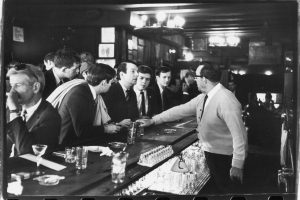
John Timmons, Dick Leitsch, Craig Rodwell, and Randy Wicker of the Mattachine Society during the 1966 “Sip-In” at Julius’ bar. Gift of the Estate of Fred W. McDarrah.
Julius’
While not directly associated with Marsha P. Johnson, the iconic Julius’ bar makes an appearance in the film. The Greenwich Village bar was the site of the 1966 “Sip-In,” at which members of the Mattachine Society, a gay rights organization formed in the 1950s, brought attention to the State Liquor Authority’s discriminatory policy of revoking the licenses of bars that served gay men and lesbians (one of several sites we’ve successfully nominated to the National Register of Historic Places for its significance to LGBT history).
In the documentary, we see Marsha’s friend and roommate Randy Wicker being interviewed at Julius’. Randy was actually one of the four participants of the “Sip-In.” In the famous photo taken by Fred W. McDarrah for the Village Voice (pictured here), you can see Randy in the back looking on as the bartender puts his hand on the glass. Learn more about this important pre-Stonewall event.
Discover more historic sites and learn more about transgender history in NYC with our curated theme.
Have recommendations for other sites significant to the transgender community in NYC? Share your suggestions and help us make trans history visible.